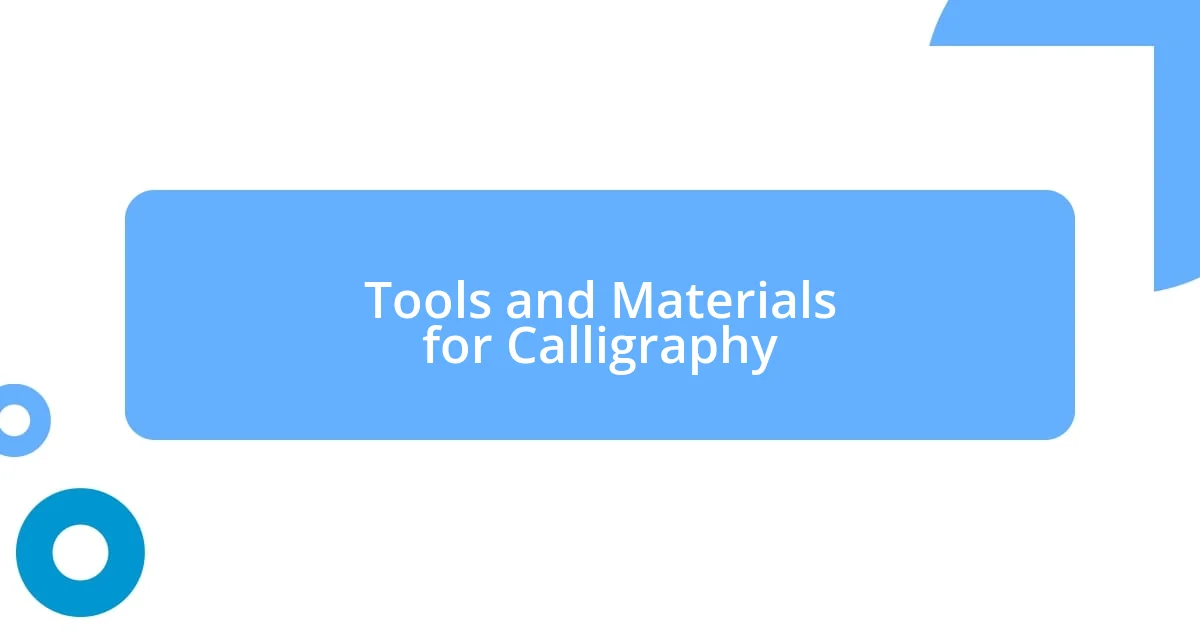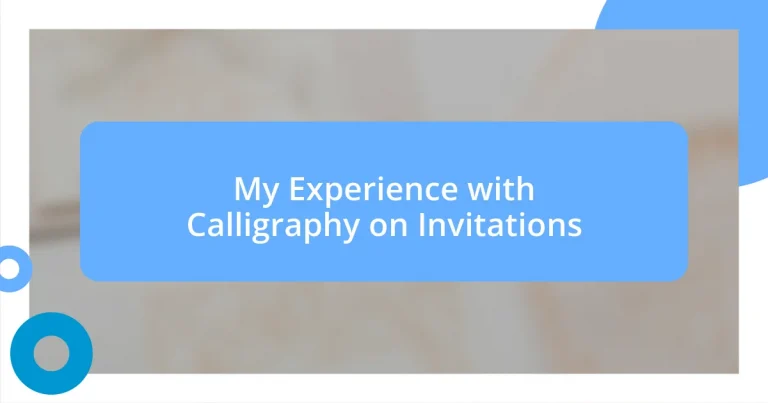Key takeaways:
- Discovering calligraphy transformed from a struggle into a joyous, meditative practice, allowing for personal expression and connection with others.
- Utilizing the right tools—such as nibs, paper, and ink—enhances the calligraphy experience, impacting the quality and vibrancy of the final design.
- Personalizing invitations through calligraphy adds heartfelt touches, making each piece a unique reflection of the event and the individuals involved.

My Journey into Calligraphy
When I first stumbled upon calligraphy, I was captivated by the elegance of the letters swirling on the page. I can still picture myself in a quaint little art store, running my fingers over the smooth nibs and colorful inks, feeling a surge of excitement as I imagined creating invitations that would dazzle my friends. Have you ever felt that rush when discovering a new passion? It’s a feeling that draws you in, compelling you to explore further.
As I began my calligraphy practice, the initial struggle was palpable. My hands trembled as I tried to connect each letter, often erasing more than I wrote in a single sitting. Yet, with each attempt, I found joy in the process; it became a meditative exercise that allowed me to express my creativity. It made me wonder: How can something so challenging also be so rewarding?
Eventually, after countless hours of practice, I found my rhythm. There’s a magical moment when the pen glided effortlessly across the paper, forming letters that felt like an extension of myself. Each stroke told a story, and each invitation became a little piece of art, a tangible reflection of my journey. Have you ever experienced that blissful state of flow? For me, calligraphy transformed from a hobby into a profound means of connection with others.

Tools and Materials for Calligraphy
When it comes to calligraphy, having the right tools can make a significant difference in your experience and results. I remember getting my first calligraphy set, which included a nib holder and a couple of different nibs. The nibs, which are the metal tips of the pens, come in various shapes and sizes to create different styles. Trying them out was like discovering a new language; each nib had its personality, influencing my strokes and ultimately shaping the design of my invitations.
Paper is another essential material worth considering. When I started, I experimented with various types, and I quickly learned that not all paper is created equal. Smooth, quality paper allows the ink to flow beautifully, preventing unwanted bleeding or feathering. My favorite paper for invites was a soft cotton blend that felt luxurious to the touch. Trust me, when the recipient runs their fingers over it, they’ll sense that extra dose of care you put into crafting their invitation.
It’s fascinating how each tool and material in calligraphy combines to create a unique experience. For instance, the ink you use contributes to the overall vibrancy and charm of your work. I fondly recall the first time I tried shimmering ink; the way it glinted in the light added an enchanting touch to my designs. So, whether you’re aiming for a classic black ink or a sparkling hue, the right combination will make your invitations truly unforgettable.
| Tool/Material | Description |
|---|---|
| Nib Holder | Essential for holding the nib; comes in various styles for grip comfort. |
| Nibs | Metal tips of different shapes for diverse lettering styles. |
| Ink | Available in numerous colors; affects the vibrancy and feel of your calligraphy. |
| Paper | Quality paper allows for smooth ink flow; can enhance the overall aesthetic. |

Techniques for Beautiful Calligraphy
There are several techniques that can elevate your calligraphy game and result in beautifully crafted letters. One approach that I found immensely helpful was focusing on consistent pressure during each stroke. It took some time for me to master the art of varying my grip – applying more pressure for downstrokes and lighter pressure on upward strokes. This simple adjustment transformed my letters from bland to visually dynamic.
- Practice Basic Strokes: Start with simple lines and curves to build muscle memory.
- Maintain a Consistent Angle: Holding your pen at a consistent angle promotes uniformity in your letters.
- Breathe and Relax: Tension in your muscles can hinder fluid movements; a relaxed grip creates flowing strokes.
- Use Guides: Initially, utilizing practice sheets with guidelines helped me align my letters properly.
Another technique that enhanced my calligraphy was experimenting with different styles. I vividly recall my excitement when I tried out pointed pen calligraphy for the first time. The sharp nib allowed me to explore elegant flourishes and loops that seemed to dance across the paper. As I dipped into vibrant inks, I felt like I was unlocking a new chapter in my creativity, giving life to invitations that truly captured the essence of each celebration.
- Explore Various Styles: From Copperplate to Gothic, trying new styles can reignite your inspiration.
- Develop a Personal Flair: As you grow more comfortable, don’t shy away from adding touches that reflect your personality.
- Work with Color: Introducing color can shift the mood of your calligraphy and make it even more eye-catching.
- Shadowing Techniques: Adding shadows or highlights can create depth and dimension in your lettering.
I found that these techniques not only improved my skills but also deepened my appreciation for the art form itself. It’s a journey of discovery, where each letter you create imbues a piece of your story.

Choosing the Right Invitation Style
Choosing the right invitation style is like curating a personal narrative; it reflects not only the event but your own unique taste. I remember a time when I had to choose the style for my best friend’s wedding invitations. I was torn between elegant script and modern minimalist designs. Each option carried a different vibe, and I felt the pressure to get it just right. After some soul-searching, I found that the invitation should mirror the couple’s personalities – a whimsical touch for their adventurous spirit resonated perfectly with their love story.
When browsing through styles, think about the overall mood you want to convey. Do you envision a vintage garden party or a sleek city affair? I once designed invitations for a rustic-themed birthday party, incorporating earthy tones and florals. Each element worked harmoniously to evoke that cozy, laid-back atmosphere, resulting in excited guests who felt the invitation alone was a warm hug. It’s fascinating how colors, fonts, and layouts can evoke specific emotions; this is where your creativity gets to shine.
Don’t hesitate to gather inspiration from various sources, but remember to hone in on what truly speaks to you. While preparing invitations for a charitable event, I scoured Pinterest, but nothing felt right until I recalled the vibrant hues of summer sunsets. I opted for bold colors paired with playful fonts, capturing the essence of joy and community that was central to the event. Asking yourself what ignites your passion can lead to selecting a style that resonates, making the invitation an unforgettable part of the celebration.

Personalizing Invitations with Calligraphy
Personalizing invitations with calligraphy brings a unique, heartfelt touch, transforming a simple card into a cherished keepsake. I remember crafting invitations for my sister’s baby shower, where I chose a soft, flowing script that mirrored her personality. As I delicately wrote each name, I could almost feel the excitement in the air, knowing that these invitations would represent a beautiful moment in our family’s journey.
One of my favorite memories involves adding little flourishes to the invitations. While addressing them, I would sometimes sneak in a tiny heart or a swirl next to a special recipient’s name. It became my way of infusing love and joy into the process. When the guests received those invitations, I hoped they could sense the warmth behind my calligraphy, creating a connection even before the celebration began. Isn’t it amazing how a small detail can make someone feel truly special?
I also found that choosing the right ink color can dramatically change the invitation’s mood. During a friend’s elegant engagement party, I opted for a deep burgundy ink that complemented the gold accents perfectly. As I wrote, I couldn’t help but smile, envisioning how each guest would light up upon receiving it. Every swirl of the pen felt like an extension of my friendship, capturing the essence of that moment in time. Personalizing invitations in this way not only elevates the aesthetic but also turns each piece into a heartfelt expression of who we are.

Tips for Practicing Calligraphy Skills
One of the best tips I’ve learned for practicing calligraphy is to embrace the concept of daily drills. I set aside just fifteen minutes each day to focus on specific letters or strokes. It was surprising to see how much improvement I made over time. Have you ever noticed how regular practice can make a task feel more natural? It’s like tuning a musical instrument; the more you play, the more in tune you become.
I also found it incredibly helpful to use guides or practice sheets with pre-drawn strokes. When I first started, I struggled with consistent slants and spacing. Using these guides allowed me to pay closer attention to my form without the pressure of creating something perfect right away. There was something calming about tracing over established lines—like falling into a rhythm that made the process enjoyable. What techniques have you found useful in your own calligraphy journey?
Another aspect that I believed truly elevated my skills was experimenting with different types of nibs and inks. In my experience, switching from a standard calligraphy nib to a flexible one opened up a whole new world of possibilities. I remember the first time I tried a fountain pen that I found at a craft store; it was like being handed a paintbrush in an artist’s studio. Each stroke felt alive and expressive, and I began to explore variations in pressure and angles. Have you considered how different tools can influence your style? Finding the right tools transformed my practice sessions from mundane to magical, letting my creativity take flight.














